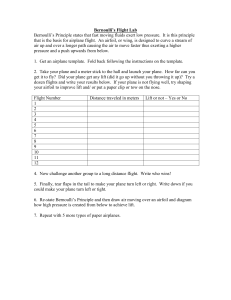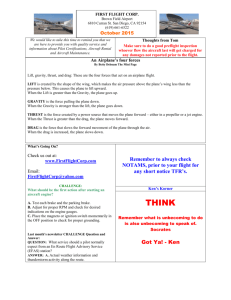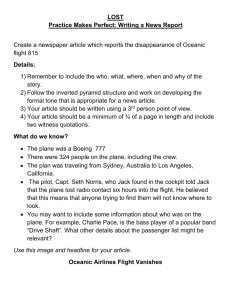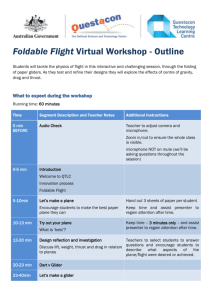Jets in Flight Science Topic: Physics
advertisement
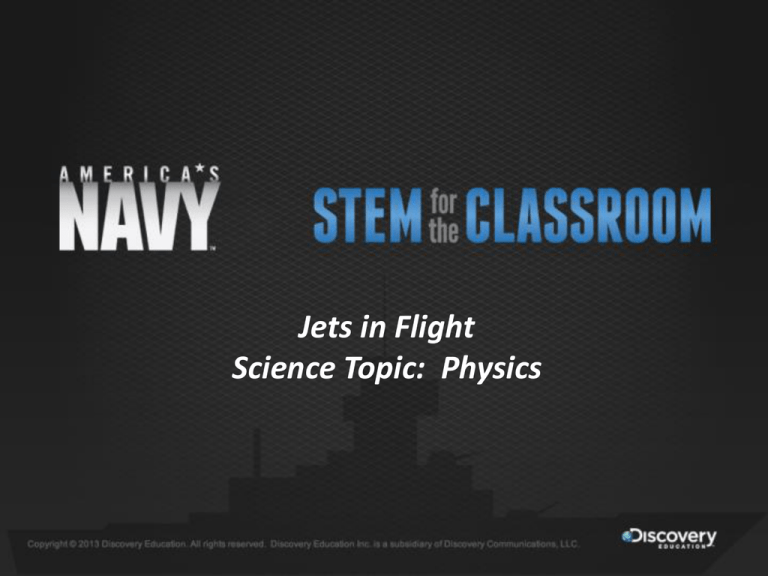
Jets in Flight Science Topic: Physics Lesson Objectives • Understand the Engineering Design Process • Comprehend the basic principles of flight • Apply the Engineering Design Process to aircraft design Navy Aviation Lesson Goal Apply the principles of flight and the engineering design process to design and construct three models of paper airplanes. 1. Fastest plane 2. Slowest plane 3. Travel the greatest distance Lesson Organization • Part 1: Understanding and applying the basic principles of flight • Part 2: Building a working prototype of three paper planes (fastest, slowest, travel greatest distance) Vital for Flight Part 1: The Principles of Flight • Forces acting on an aircraft in flight – Thrust: the force that propels an aircraft forward – Drag: air resistance that produces a force in the opposite direction of thrust – Weight: gravitational force – Lift: upward force acting in the opposite direction of weight • Flight is achieved by shifting the balance between the opposing forces • Thrust is produced in one of two ways: – Transfer of momentum when gases are ejected to the rear of the plane through jet engines – Launching a plane with a catapult from the deck of an aircraft carrier Take out a sheet of paper Hold it portrait style at both sides Blow over the surface of the paper Make your observations, draw a diagram, and write questions and answers *What happens to the paper as the air flow increases speed? *Why is this happening? Lift is the upward force created as air passes over and beneath the wings of an aircraft • Bernoulli’s Principle: 1. Fast moving air at the top edge of the wing creates a zone of low pressure • Bernoulli’s Principle: 2. Slow moving air along the bottom edge of the wing has the same pressure as the air at the front of the wing (Ambient Pressure) • Bernoulli’s Principle: 3. The difference in pressure creates the force of lift • Lift Momentum: additional upward force is generated incoming air deflects off the bottom of the wing and transfers momentum to the wing Part 2: Designing a Prototype You are an engineer tasked with building three paper plane prototypes. The prototypes will be planes that can fly the fastest, slowest, and the greatest distance. The Navy plans to use these models in covert operations to collect intelligence. You may use only approved materials provided by the Navy as described in the Resources List. Maintain a record of your design process on your lab sheet for post-Design assessment and presentation. Resources List Project Design Requirements 1. 3 total drawings, one of each plane, include labels and measurements (metric) 5 points for each, total=15 points 2. Data table of each plane with flight data (see next slide) 5 points for each, total =15 points 3. 3 paragraph summaries (one for each design): What changes did you have to make to each plane to improve its performance? (include drawings and explanations of why and how changes affected results) 5 points for each, total =15 points 4. Presentation to class of prototypes, drawings, data tables, and explanations. Total Project Points=45 points! Data Table of Fastest Plane Trial Number Distance traveled (meters) Time (seconds) Speed (speed=distance /time) 1 2 3 Average Speed= (speed 1 +speed 2+ speed 3)/3 Do 3 data tables: fastest plane, slowest plane, longest distance Resources • http://www.av8n.com/how/htm/4forces.html • http://www.aerotraining.com/reference/AC%206123C_Chapter_1_Canada.pdf • http://www.grc.nasa.gov/WWW/k12/BGA/Sheri/the_lift_equation_act.htm • http://www.fighter-planes.com/info/f18.ht • http://www.grc.nasa.gov/WWW/K-12/airplane/foil2.html
